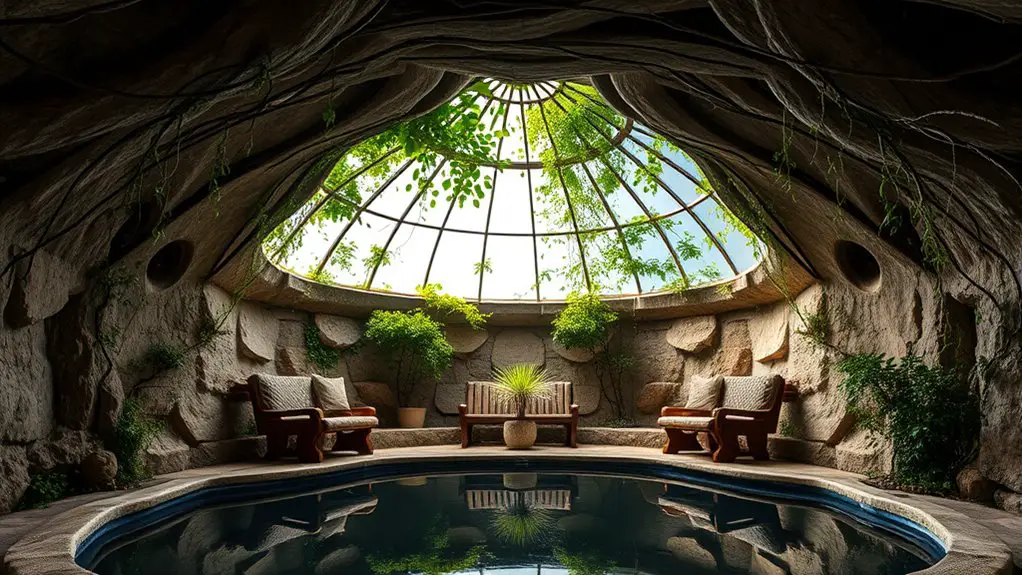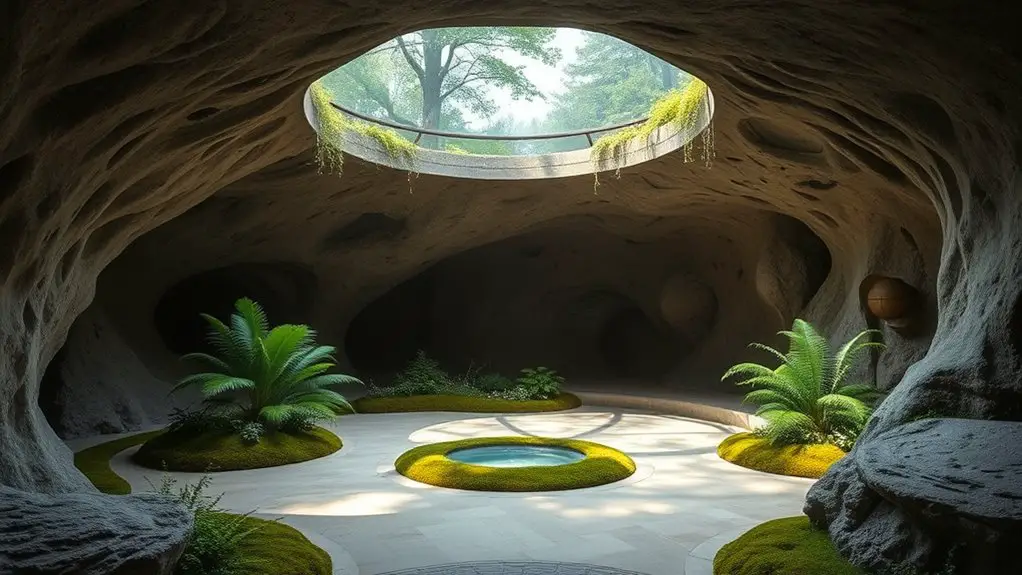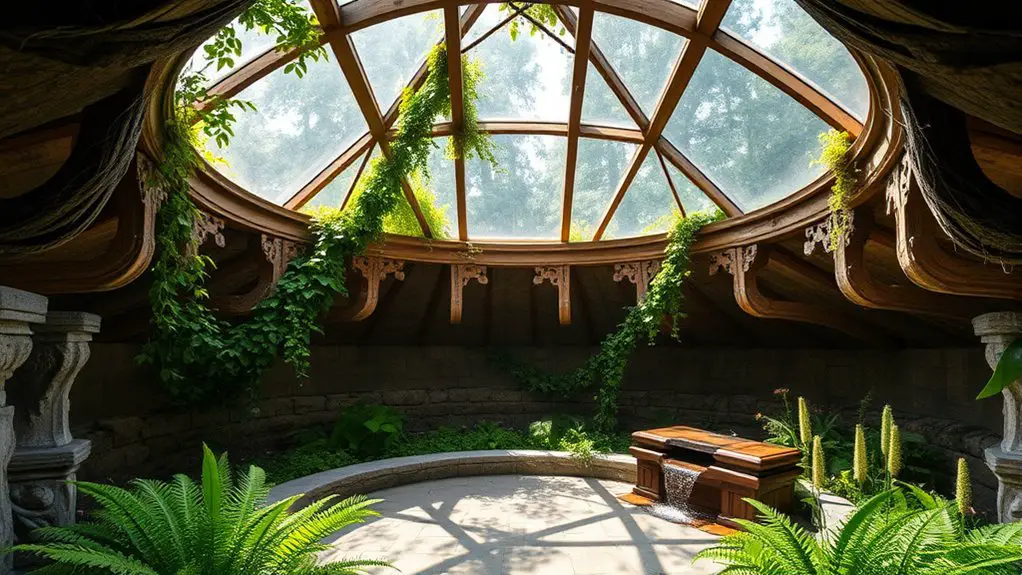Underground gazebos are indeed possible, merging nature and architecture for a unique outdoor experience. They enhance privacy and offer innovative design potential, while careful planning guarantees structural integrity and moisture management. With benefits like temperature stability and soundproofing, they redefine personal spaces. However, challenges like excavation and drainage must be considered. As interest in sustainable and biophilic designs grows, there’s much more to explore about these intriguing structures and their place in modern outdoor architecture.
The Concept of Underground Gazebos

The idea of underground gazebos presents a unique blend of nature and architecture, redefining outdoor spaces. These innovative structures challenge conventional notions of beauty and usability in landscaping. By immersing gazebos into underground landscapes, you’re not only maximizing space but also enhancing privacy and creating a sense of seclusion. Conceptual designs for these gazebos can incorporate natural elements, such as soil, rock, and native plants, fostering a harmonious connection with the environment.
Imagine a space where sunlight filters through strategically placed openings, illuminating a serene retreat. This approach allows for the exploration of vertical gardening and sustainable practices, contributing to environmental harmony. Additionally, the acoustics of an underground gazebo can provide an intimate atmosphere, ideal for gatherings or solitary reflection. Embracing this concept can liberate your imagination, inviting a new era of outdoor living that harmonizes architectural innovation with the untouched beauty of nature.
Design Considerations for Subterranean Structures
When designing subterranean structures, you must prioritize structural integrity and stability to withstand earth pressures and environmental factors. Additionally, effective ventilation and the incorporation of natural light are essential for creating a comfortable atmosphere. Balancing these elements guarantees that your underground gazebo is not only functional but also inviting.
Structural Integrity and Stability
Structural integrity and stability are paramount when designing subterranean structures like underground gazebos. You’ll need to carefully consider foundation materials that can withstand external pressures and moisture. Selecting materials like reinforced concrete or steel can enhance durability and resistance to shifting soil. Effective load distribution is also essential; it guarantees that weight is evenly spread across the structure, reducing stress on any single point. This can be achieved through innovative design techniques, such as arching or doming, which naturally distribute forces. Additionally, incorporating proper drainage systems will protect against water accumulation, further contributing to stability. By understanding these principles, you can create a safe and inviting underground haven that embraces your desire for freedom in design.
Ventilation and Natural Light
While you might envision an underground gazebo as a cozy retreat, ensuring adequate ventilation and natural light is essential for comfort and functionality. Effective design should prioritize natural ventilation to maintain air quality and regulate temperature. You can achieve this through strategically placed vents or openings that allow airflow without compromising aesthetics.
Here’s a table to evaluate various light sources:
| Light Source | Benefits |
|---|---|
| Skylights | Maximizes natural light |
| Windows | Enhances airflow |
| Solar tubes | Efficient light transfer |
| LED fixtures | Energy-efficient choice |
| Reflective surfaces | Amplifies existing light |
Benefits of an Underground Gazebo

Although the concept of an underground gazebo may seem unconventional, its benefits are both practical and aesthetic. Imagine creating a serene space that seamlessly integrates with your landscape while offering remarkable insulation. An underground gazebo can maintain a stable temperature, making it ideal for year-round use. Additionally, it allows for innovative underground gardening, where you can cultivate plants that thrive in consistent conditions.
Acoustic benefits also play a significant role. The earth acts as a natural sound barrier, reducing noise pollution and enhancing your experience of tranquility. You’ll find that conversations resonate in a more pleasant way, free from the distractions of the outside world.
Furthermore, an underground gazebo can serve as a unique focal point, blending creativity and functionality. With thoughtful design, it can become a retreat that reflects your desire for freedom and connection to nature, all while being tucked away beneath the surface.
Potential Challenges and Drawbacks
Even with its myriad advantages, an underground gazebo presents several challenges that homeowners should carefully consider. First and foremost, safety concerns arise from potential structural integrity issues. You’ll need to guarantee that the design can withstand soil pressure and moisture, which can lead to dangerous collapses if not managed effectively.
Excavation difficulties also pose a significant challenge. The process of digging can be labor-intensive and costly, particularly if your yard has rocky or unstable soil. Additionally, you might encounter underground utilities that complicate the excavation process, requiring careful planning and potentially hiring professionals.
Moreover, the risk of flooding or water accumulation must be addressed, as inadequate drainage could turn your serene retreat into a soggy mess. Balancing these challenges with the desired benefits is vital to guarantee your underground gazebo is both functional and safe, allowing you the freedom to enjoy your space fully.
Aesthetic Options for Underground Spaces

As you consider aesthetic options for your underground gazebo, it’s essential to balance functionality with visual appeal. Using aesthetic materials like natural stone, reclaimed wood, or metal can create a harmonious blend with your environment. These choices not only enhance the structure but also contribute to a sense of tranquility in this unique space.
Incorporating underground landscaping is vital too; think about integrating plants that thrive in low-light conditions. Ferns, moss, and shade-tolerant flowers can soften the hard edges of your gazebo, bringing life to the subterranean atmosphere. Lighting plays a pivotal role as well—opt for energy-efficient LED options that mimic natural daylight, enhancing the ambiance without overwhelming the senses.
Finally, consider the layout and flow of your underground space. Open designs with curved lines can evoke freedom, inviting creativity while maintaining a cozy feel. This thoughtful approach will transform your underground gazebo into a stunning retreat.
Case Studies of Existing Underground Gazebos
When examining existing underground gazebos, you’ll notice a range of innovative designs that push architectural boundaries. However, these projects often encounter significant structural challenges, such as soil stability and moisture control. Understanding these case studies reveals the unique benefits that underground features can offer, enhancing both functionality and aesthetic appeal.
Innovative Design Examples
While traditional gazebos often rely on above-ground structures to create inviting outdoor spaces, innovative underground gazebos challenge this norm by blending functionality with unique aesthetics. These designs often utilize eco-friendly materials and smart technology, creating spaces that are not only visually striking but also sustainable.
| Design Example | Features |
|---|---|
| The Earth Shelter | Made from rammed earth, features natural insulation. |
| The Subterranean Retreat | Smart lighting and ventilation systems, built with recycled materials. |
| The Green Canopy | Integrated green roofs, utilizing solar energy for power. |
| The Living Bunker | High-tech security and climate control, crafted from sustainable composites. |
These examples illustrate how underground gazebos can redefine outdoor living, offering a harmonious blend of nature, innovation, and sustainability.
Structural Challenges Faced
Innovative underground gazebos may redefine outdoor spaces, but they also come with a unique set of structural challenges. You’ll need to take into account several critical factors to guarantee safety and durability:
- Load bearing materials: Selecting appropriate materials is crucial for supporting the structure’s weight.
- Soil stability: Understanding soil composition and stability is fundamental to prevent subsidence or shifting.
- Water management: Effective drainage systems must be integrated to avoid water accumulation and erosion.
- Ventilation: Proper airflow is necessary to maintain a comfortable environment and prevent moisture buildup.
Each of these challenges requires careful planning and engineering to create a secure and enjoyable underground gazebo. By addressing these concerns, you can achieve an innovative and functional outdoor retreat.
Benefits of Underground Features
Although the concept of underground gazebos might seem unconventional, their benefits are becoming increasingly evident through various successful implementations. These unique structures offer exceptional underground insulation, ensuring a comfortable environment year-round. Additionally, you’ll appreciate the significant soundproofing benefits, allowing for serene gatherings away from urban noise.
| Benefit | Description |
|---|---|
| Underground Insulation | Maintains stable temperatures, reducing energy costs. |
| Soundproofing Benefits | Blocks external noise, enhancing relaxation and privacy. |
| Aesthetic Appeal | Blends seamlessly with nature, providing a unique experience. |
| Space Efficiency | Maximizes usable space without disrupting the landscape. |
With such advantages, it’s clear underground gazebos can redefine personal leisure spaces.
Future Trends in Outdoor Architecture
As outdoor architecture evolves, we’re witnessing a shift toward designs that seamlessly integrate with their natural surroundings. This movement emphasizes the use of sustainable materials and innovative urban integration, reflecting a growing desire for harmony between human constructs and the environment.
Key trends shaping the future include:
- Biophilic design: Incorporating natural elements to enhance well-being.
- Modular structures: Allowing flexibility and scalability in outdoor spaces.
- Smart technology: Enhancing functionality through automation and energy efficiency.
- Eco-friendly materials: Prioritizing renewable resources to minimize environmental impact.
These trends not only foster a sense of freedom in outdoor living but also promote resilience in urban settings. As you consider your next outdoor project, embracing these principles can lead to spaces that resonate with both nature and community, ultimately redefining the essence of outdoor architecture for generations to come. Additionally, incorporating features like shade structures can greatly enhance outdoor comfort and usability.
Frequently Asked Questions
Can Underground Gazebos Be Built in Areas With High Water Tables?
When considering underground structures in high water table areas, you’ll need effective water management strategies to maintain structural integrity. Innovative designs can allow for stability, but careful planning is essential to avoid potential flooding issues.
What Materials Are Best for Constructing an Underground Gazebo?
Did you know that up to 60% of structural failures occur due to inadequate materials? For your underground gazebo, consider durable concrete options and effective wood treatments to guarantee longevity, stability, and resistance against moisture.
How Do You Ensure Proper Ventilation in an Underground Gazebo?
To guarantee proper ventilation in your space, consider integrating advanced ventilation systems that facilitate ideal air circulation. Utilizing fans and strategically placed vents can create an invigorating atmosphere, enhancing your experience while maintaining comfort.
Are There Specific Building Codes for Underground Structures?
In many regions, over 60% of underground structures require specific building permits due to safety regulations. You’ll need to research local codes to guarantee your project meets all necessary guidelines and safeguards for underground construction.
How Do You Maintain an Underground Gazebo’s Aesthetics Over Time?
To maintain an underground gazebo’s aesthetics, incorporate design elements that resist moisture and decay. Regular maintenance techniques, like applying weather-resistant finishes and periodic inspections, guarantee longevity while preserving the unique charm of your space.

